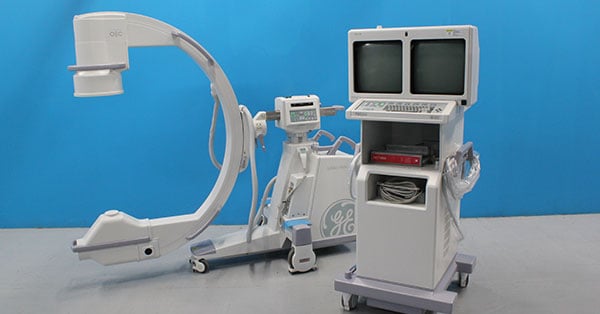
The OEC 9800 Super-C is a common and popular option on the refurbished C-arm market, but when first-time C-arm buyers come across it in our inventory, they often ask, "What exactly is so 'super' about this thing?"
Well, in most cases, “super” means something extra above and beyond the average; “Super-sizing” gets you more fries, the “Super Soaker” shoots a few feet further than other water guns.
In the case of OEC C-arms, “Super-C” means a little more C. We'll tell you exactly what the differences are and what they mean for users.
What's different about the Super C?
Arc Depth
The primary difference between a Super-C and standard units is the depth of the arc of the C. Compared to a standard C-arm with a 9” image intensifier (II), the Super-C has an extra 7”. The Super C has 5” more in the arc compared to the 12” II configuration. This difference in arc depth offers Super-C users 148 degrees of orbital rotation as opposed to the 115 degrees afforded standard C users.

With the extended rotation, Super-C users can accomplish scans that previously would have required repositioning of the patient by simply repositioning their c-arm instead. This offers greater flexibility in the OR and saves time.
L-Arm Design
Another difference is the design of the L-arm between the body of the unit and the arc of the C. The L-arm of the Super-C was shortened to accommodate the increased dimensions of the C. This change does not affect the side-to-side rotation of the Super-C.


Overall Size
In overall size, the Super-C resides between the slightly smaller standard 9” II configuration and the slightly larger standard 12” configuration. The difference in either direction is 2” or less in both height and length. The monitor carts of all three styles share identical dimensions.
View the C-Arm Model Size Comparison Infographic
Price
The final (and most-often inquired after) difference is in pricing. The buyer looking to purchase a Super-C can expect to pay an average of 5 - 10% more than the price of a standard C.
The Takeaway
Pain management and cardiac-focused physicians (and anyone else using the oblique view) will see a decided advantage from the extra rotation of the Super-C. Other applications certainly won't see any disadvantage from having a Super-C, but might be able to forego the extra cost.
Whatever your specific application, we're here to help you select the best C-arm for your facility. If you're ready to start now, contact us with the button below. For those of you who'd like to do a little more homework, check out some of our related blogs below.

Chris Sharrock
Chris Sharrock is the Vice President of Healthcare Solutions at Block Imaging. Each day Chris sets out to provide the best equipment, parts, and service solutions for healthcare facilities across the world. Outside of work Chris enjoys playing in a band, and spending time at the lake with his family.




